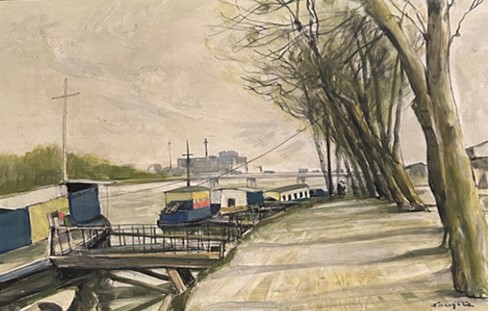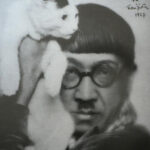
Léonard Tsuguharu - Foujita
Japanese, 1886-1968 (active France)
Le Port De St. Cloud, 1939
Oil on canvas
10 5/8 x 14 in.
SBMA, Gift of Hall and Lenore Adams
1987.29

Photograph by: d'Ora (Dora Kallmus), 1932
“Consider me dead until I become famous.” – Leonard Tsuguharu-Foujita
“Only the power of art can transcend borders and racial barriers to penetrate the heart of man. In the friendship between two countries, the most useful exchange is that of artists. That is why I have worked every day of my life even if people tend to say: but he is only a painter!” - Leonard Tsuguharu-Foujita
RESEARCH PAPER
Léonard Tsuguharu-Foujita was born on November 27, 1886, in Ushigome, a former ward of Tokyo, during the Meiji era. He was the son of Fujita Tsuguakira Fujita, an Army Medical Director and aristocrat. He developed an interest in painting in primary school and, at adolescence, decided to become a painter. At age 14, one of his watercolors was exhibited at Paris’s Exposition Universelles, during which time his love of Paris blossomed. He studied French in high school and wanted to go to France, but his father urged him to continue his art studies in Japan. He enrolled in 1905 and completed his initial training at the Tokyo National University of Fine Arts and Music (formerly, the Tokyo University of the Arts). There, he studied both western and Japanese style painting.
He moved to Paris in August 1913 to follow his artistic dreams and immediately went to work copying old masters at the Louvre where he was influenced by Michelangelo, Poussin, and Rodin. Foujita based himself in the Montparnasse district, producing paintings in the hope of exhibiting at the Salon d’Automne, an important venue for aspiring young artists.
Foujita’s move to Paris brought him great success – success few Japanese expatriates shared. The French were entranced with the traditional Japanese woodblock style, and regarded Japanese artists’ attempts to work in Western styles as false, forcing many to return to traditional techniques to earn a living, or to abandon art altogether. Foujita was able to establish a distinctive personal style – a combination of Western oil painting and Japanese calligraphic techniques. It allowed him to explore new forms while still catering to the Japonist tastes of the public.
Foujita quickly became famous in the international modernist art scene both for his art and for his lifestyle. Foujita’s showy persona, party lifestyle, and a distinctive fashion sense, consisting of a fringed haircut, gold earrings, and round glasses allowed him to blend into nonconformist circles and form friendships with other artists. He joined the bohemian group, the Ecole de Paris, where he was a fixture in the avant-garde art scene and became close friends with fellow Montparnasse painters: Chaïm Soutine, Amedeo Modigliani, Ossip Zadkine, Marie Laurencin, Raoul Dufy, Robert Desnos, Jean Cocteau, Juan Gris, Pablo Picasso and Henri Matisse. Like his persona, Foujita’s art style was exceedingly attractive to both artists and wider audiences.
The First World War broke out in 1914, and Foujita decided to remain in Paris and develop his own expression in the landscapes of Paris’s streets. Foujita was attracted not by the dazzling sites of Paris or the pastoral suburbs, but rather by the lonely landscapes on the peripheries of the old city. Paris, once a fortified city, was surrounded by walls and embankments. The city expanded at the beginning of the twentieth century, with immigrants and the poor settling on its periphery. The beginning of the twentieth century was a time when city margins became subjects of attention, and this included Paris. Along with the other artists of the period such as Eugène Atget and Henri Rousseau, Fougita focused his artistic gaze on the perimeter edges of the city of Paris.
Foujita’s paintings studied the old wall surrounding the city and its gates. Just as Rousseau was drawn to the landscapes of the suburbs outside the city, Foujita, living in poverty, found what he was looking for in the lonely places at the margins of the city. He claimed that art should not be produced just for wealthy individuals but also for the masses and the broad public, which this subject matter addresses.
The Paris city walls reminded Foujita of the Edo Castle of his boyhood. The connection between the two old fortifications served as a foundation for him. Self-trained in landscape painting, Foujita established his own technique and became the first Japanese painter to be acclaimed in Paris. The paintings from his later years attest to Foujita’s sustained affection, since the time of his first arrival, for the landscape of the city of Paris.
The 1939 oil painting of “Le Port De St. Cloud,” a station of Line 9 the Paris Métro, resembles his earlier works (1913-1924), in that it is a desolate, somber Paris cityscape. Unlike the Nabis’ or the Fauves’ paintings, his were bled of color and he attempted neither abstraction nor cubism but sought to exhibit his unique Japanese-style paintings that had been infused with French oil painting techniques.
“Le Port De St. Cloud” is painted in mostly creams, browns, and beiges, with some color added in the houseboat/barges. Japanese calligraphic influence can be seen in the very thin but strong line he uses to illustrate the trees. His merged French/Japanese style is seen in the muted and fuzzy tree shapes delineated by the sharp lines of the branches. The painting is divided in half horizontally, with the top half consisting of trees and sky and the bottom half consisting of richer hued boats, a walking path, and a dock in the foreground. The painting’s bottom half is divided diagonally into two parts, leading the eye up the painting.
The paint textures and subtlety of muted colors are visually interesting. The sky, water of the Seine reflecting the sky and the pathway are all beige. There are four vertical crosses in the near and far background that mirror one another. The squared off boats and structures are softened by the swaying trees and softly tread path. Poussin’s influence is felt in that this painting favors line over color. Diagonal and lines run through the painting; from left to right, with the angle of the path, from right to left with the angle of the trees and vertically, with the crosses. His milky white background and the black lines of his trees combined French oil painting techniques and the “rigor of the Japanese line with the freedom of Matisse” as he said himself.
Combining Western and Eastern techniques, Foujita was known for the fine line that he achieved with the menso, a traditional Japanese ultra-thin brush. In this landscape, the finesse of line is enhanced by a milky-white glaze, generating a pearlescent effect unique to the artist.
Foujita’s calligraphic line recalls the Japanese tradition of gauzy shapes on almost transparent backgrounds, and he adheres to a very individual blend of Asian tradition and Western figuration. His trademark white background allows him to draw fine lines and render textures with subtle glazes and thin paint. Foujita’s unclassifiable style survived the great modernist currents of the early twentieth century, fauvism, cubism, surrealism.
Painting was just one of Foujita’s talents. Between his interest in modernity and tradition, between East and Western cultures, and between art and craftsmanship, he was a virtuoso in many areas. He was an engraver, a draftsman, illustrator, sculptor, ceramist, photographer, filmmaker, fashion designer, etc. He is an unclassifiable Franco-Japanese creator, whose work expresses a fusion unique to the history of 20th century art. The mixture of European models and Japanese sensibilities is his most consistent stylistic quality in an otherwise varied body of work.
Referred to as "the most important Japanese artist working in the West during the 20th century", Fougita designed, constructed and decorated the Chappelle Notre Dame-de-la-Paix (the Chapel of Our Lady Queen of Peace), known as the Chapelle Foujita in Reims. Foujita designed and finished the frescos and stained-glass windows at this chapel, where he is now buried. He died on January 29, 1968.
Prepared for the Santa Barbara Museum of Art Docent Council by Michelle Kling, 2025
BIBLIOGRAPHY
“Artists on the edges of Paris: Le Douanier Rousseau, Foujita, and Atget.” Pola Museum of Art. Web. 10 Sept. 2016. Accessed 18, Jan. 2025.
https://www.polamuseum.or.jp/en/exhibition/20160910s01/
“Collecting guide: Léonard Tsuguharu Foujita.” Wang, A. Web. 4 Sept 2019. Accessed 19, Jan. 2025.
https://www.christies.com/en/stories/leonard-tsuguharu-foujita-artist-collecting-guide
“Foujita in Paris: women, cats and war. The greatest of Japan’s modern painters, merits rediscovery.” Judith Benhamou-Huet. Web. 15 Jan. 2025. Accessed 18, Jan. 2025.
https://judithbenhamouhuet.com/paris-foujita-women-cats-and-war-the-greatest-of-japans-modern-artist
https://artetglam.blogspot.com/2017/06/la-visite-de-la-maison-atelier-de.html Accessed 18, Jan. 2025.https://collections.sbma.net/objects/9815/le-port-de-st-cloud
